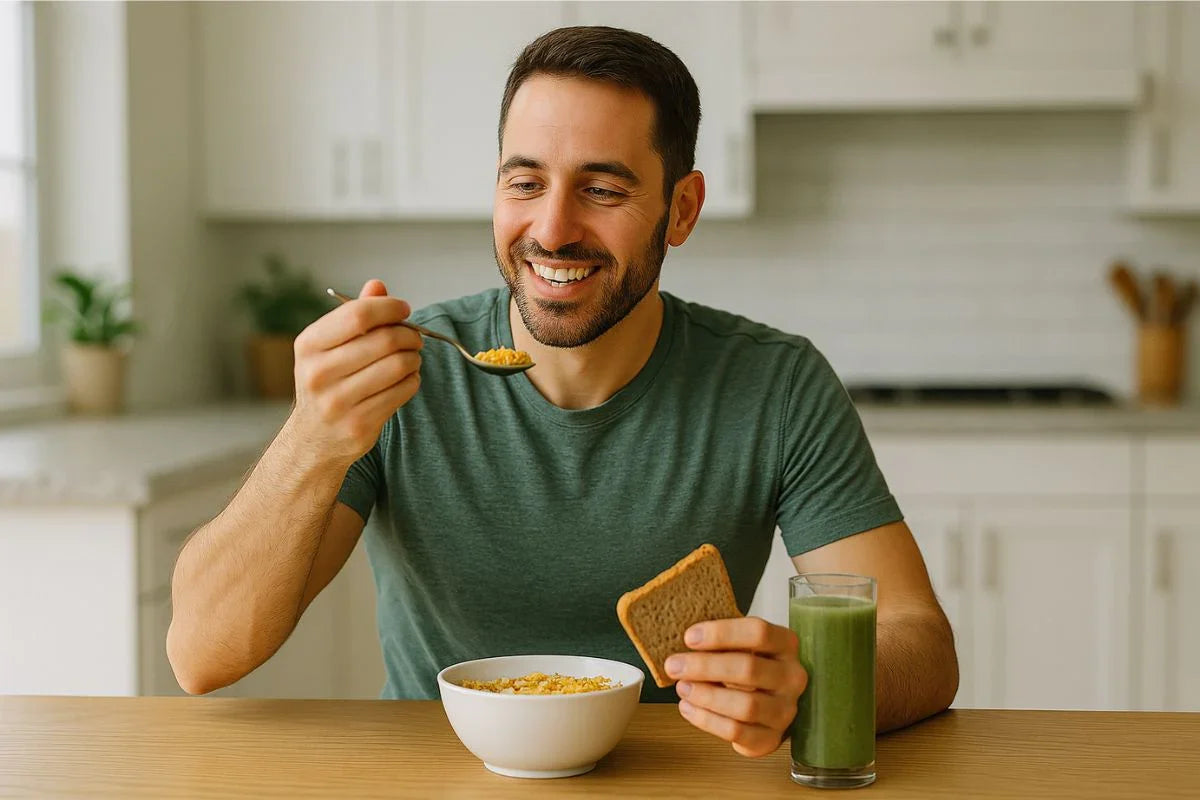
Fiber is what your intestines can build on
Everything we eat is digested. Well, almost everything. There are certain carbohydrates our body cannot absorb. These substances are called fibers, or dietary fibers. Most fibers are simply excreted again. In principle, fibers don’t do anything—or at least, that’s what is often thought.
Fibers not only help stimulate regular bowel movements and generate a feeling of fullness. Certain types of viscous fibers can slow down the absorption of nutrients in the intestines by forming a gel in our small intestine. This makes it harder for nutrients to move toward the intestinal wall, and it takes longer before they are digested. Without these fibers, most nutrients are absorbed rather quickly in the small intestine, right after the food leaves the stomach.
Cholesterol
A lot of cholesterol is also present in our intestines. If there were no fibers, all of it would be absorbed by our body. Most cholesterol, however, sticks to the fibers and is excreted along with them.
Low in calories
Fibers contain few calories. They are also light and take up a lot of space. This means they can fill your stomach and intestines without providing energy. Fiber-rich foods can therefore contribute to a low-calorie diet.
Fibers take up space and are low in calories. Fiber-rich foods, such as vegetables, are therefore very filling.
Better gut flora
Just like us, our gut bacteria get hungry sometimes. Fortunately, this hunger can be satisfied by certain fibers. These fibers are called fermentable fibers. As you can read in the blog on probiotics, a healthy gut flora is very important for our health. Feeding your own bacteria with some fibers certainly does no harm.
In return, the bacteria in the intestines produce important nutrients and short-chain fatty acids such as butyrate, acetate, and propionate.
Recommended daily amount
The average Dutch person eats between 18 and 23 grams of fiber per day. This is much less than the recommended daily amount, which lies between 30 and 40 grams depending on age and sex. So overall we eat too little fiber—especially compared to the Hadza! This traditional hunter-gatherer tribe from Tanzania eats about 100–300 grams of fiber daily. It’s no coincidence that the composition of the Hadza’s microbiome is extremely diverse and their health is remarkably good.
Sources of fiber
You probably think, like almost everyone, that prebiotic fibers are only found in vegetables, fruits, nuts, grains, and legumes, but that’s not correct. Meat and fish also contain “animal fibers” or “animal prebiotics.” For this, however, you need to eat the tougher tissues such as cartilage, organ meats, skin, bones, or ligaments.
These animal tissues also contain carbohydrates in the form of glycoconjugates—carbohydrates bound to a protein, fat, or another carbohydrate. These types of carbohydrates are not only found in meat but are also important components in raw (mother’s) milk.
The most common prebiotics are complex polysaccharides such as glycosaminoglycans and chondroitin sulfate. These fibers are not comparable to the plant-based varieties, and most likely a mix of both types in the daily diet is most optimal. Collagen, glucosamine, and chondroitin are nearly as effective at stimulating butyrate as fructooligosaccharides (FOS).
The glycome
Glycobiology is the science of the structure, biosynthesis, and biology of glycans (also called sugar chains or carbohydrates), which are widespread in nature. Sugars are essential building blocks of all organisms, and their various functions are studied scientifically across medical, biochemical, and biotechnological fields.
There are an estimated 2 million carbohydrate-containing glycans. Collectively, this is called the glycome. The glycome is considered one of the most complex entities in nature—surpassing even the complexity of the proteome.
Acellular vs. cellular carbohydrates
An important distinction between different types of carbohydrates can be made based on “acellular” and “cellular”—whether the carbohydrates are trapped in cellulose fibers or exist as “free” carbohydrates.
Carbohydrates eaten in prehistoric times came from tubers, fruits, vegetables, plant stems, and leaves. In these food sources, carbohydrates are stored in living cells with cell walls (cellulose). From this fact comes the term “cellular” carbohydrate. You could also see it as a non-absorbable form of carbohydrate.
Cellular carbohydrates are very robust and can withstand cold, heat, cooking processes, and digestion in the small intestine. As a result, they travel far into the intestinal tract. Deep in the colon, the fibers are eventually fermented and serve as a food source for the microbiota—specifically the beneficial gut bacteria.
On the other side are the “acellular” or “free” carbohydrates. These are found in many modern food products such as flour, sugar, and processed starches. Because the carbohydrates are not held by cellulose, absorption is much faster. As a result, they don’t reach deep into the intestines where they should act as prebiotics.
The amount of carbohydrates in modern food products is also much higher. In combination with rapid absorption, this can cause local dysbiosis in the intestines. Just like plant fibers, you also want prebiotics to reach the colon. Eating whole oysters with minimal or no chewing is also good for the microbiota.
Summary
Fibers are technically not nutrients for humans, since we cannot absorb their carbohydrates and therefore cannot use them directly. Carbohydrates from whole food sources (cellular carbohydrates), however, are nutrients for the little helpers in our intestines. This is the important interaction between host and bacteria—with benefits for both sides.
The type of carbohydrates you eat can therefore have major consequences for gut bacteria and overall health. Dr. Spreadbury even thinks this may be the most important factor between modern diets and ancestral diets.
A similarity between animal and plant-based prebiotic carbohydrates is that they are both bound and not easily released. These carbohydrates do not raise blood sugar levels and do not count as calories.
If you don’t eat enough fiber, prebiotic supplements can be a good addition to your regular diet.


